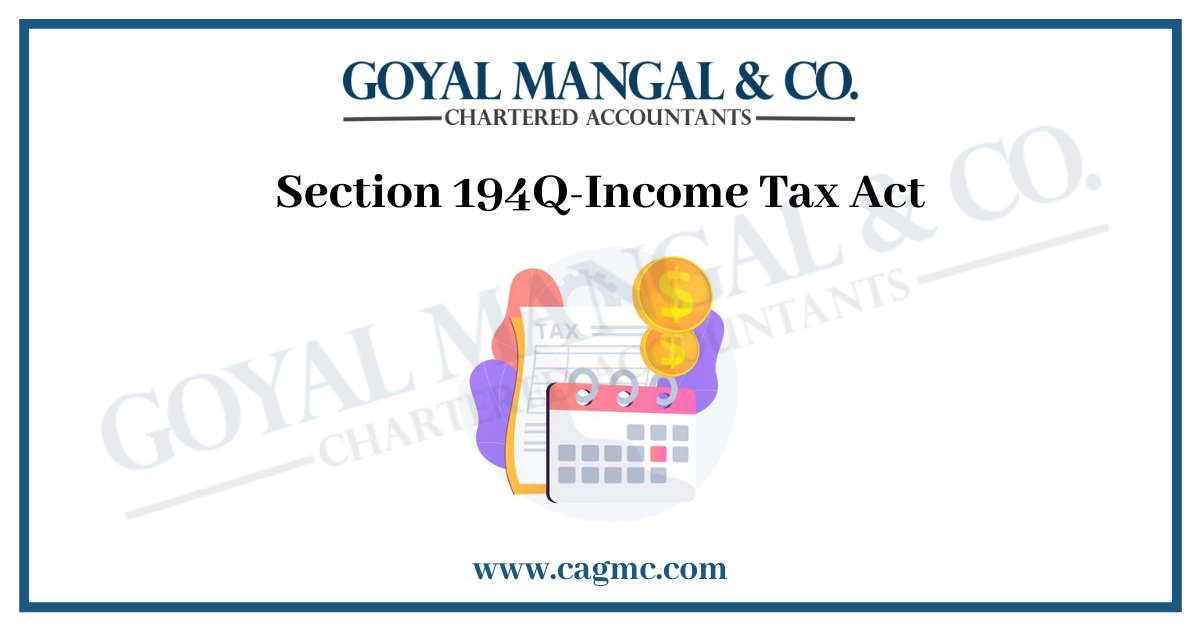
The Finance Act 2021 has introduced a new section which has come into effect from 01.07.2021. Being a TDS Section, it focusses on the buyer who is required to pay for the purchase of goods if the aggregate value of the goods exceeds Rs 50 lacs in a financial year, to deduct TDS at the rate of 0.1% at the time of payment or credit to the seller whichever is earlier. If the seller does not provide Permanent Account Number (PAN) or Aadhar Number to the buyer the TDS rate increases to 5% from 0.1%
| Table of Contents |
What does Section 194Q imply?
The rules of Section 194Q are quite new which is concerning the buyer who pays to the resident to deduct the tax either at the time of depositing such amount in the account of the seller or paying him through any other mode.
It has become important for the deductor to give complete information about the amounts on which TDS has not been deducted.
Definition of Buyer under Section 194Q
Buyer is a person who carries out business and the turnover, gross receipts or sales from his business exceeds Rs 10 crores in a particular financial year immediately preceding the financial year in which goods are purchased.
Who actually deducts the tax?
- The buyer who deducts tax should be a person which includes individuals, HUF’s, Companies, Partnership Firms, LLP’s, BOI, Local Authorities, Artificial Juridical Person.
- It further clarifies that any individual, HUF, Company, Partnership Firm, LLP, BOI, Local Authority or Artificial Juridical Person whose turnover exceeds Rs 10 crore in previous financial year is required to deduct tax.
Rate of Tax
The TDS shall be deducted at the rate of 0.1% of the amount to be paid to the seller for purchase of goods. But if the seller does not provide his PAN or Aadhar Card or has not filed his Income Tax Return for two financial years preceding the current year plus the aggregate of tax deducted at source and tax collected at source exceeds Rs 50000 in these two years, higher rate of tax shall be charged as per the provisions of the Section 206AB and Section 206CCA.
Time for Deduction of tax
- When the buyer purchases goods from the seller of the aggregate value exceeding Rs 50 lacs in a financial year, tax is deducted at the time of crediting the amount in the account of the seller or paying him/her through any other mode which is earlier.
- In case advance payment is made for purchasing the goods, tax shall be deducted.
Who is the deductee?
The seller being a deductee should be a resident of India and who receives the payment of goods.No tax shall be deducted in case of non-resident.
Difference between Section 194Q and Section 206C(1H)
- The Section 194Q is similar to Section 206C(1H).But the difference exists only in context of the deductor.
- The tax is deducted by the buyer in Section 194Q whereas tax is deducted by the seller in Section 206C(1H)
- Otherwise the rate of tax or the threshold limit, turnover limit, or the time for deduction of tax is same in both the sections.
Relationship between Section 194Q and Section 206C(1H)
- Where the buyer is deducting tax under Section 194Q for the purchase of goods at the rate of 0.1% of the value of goods and is required to deposit the TDS, he/she shall not be asked to deposit the tax- TDS/TCS if Section 206C(1H) applies to him/her.
- This implies that Section 194Q and 206C(1H) stands independent. If one section is applicable the other section automatically will not be required to be adhered to by the deductor.
Example 1:
- Mr X does trading of goods and the value of sales in the previous FY exceeds Rs 10 crore.
- In the current Financial Year he purchased goods valuing Rs 80 lacs from Y Ltd whose turnover is Rs 12 crore in the previous financial year
- Mr X will have to deduct TDS at the rate of 0.1% on (80-50) that is Rs 30 lacs under section 194Q and Y Ltd is liable to collect tax at the rate of 0.1% on (80-50) that is Rs 30 lacs.
- But in the present scenario as per the relationship discussed between Section 194Q and Section 206C(1H), both the Sections cannot overlap each other, therefore only Mr. X shall be required to deduct tax on the amount paid to Y Ltd in this transaction.
Example 2:
- Mr C purchased goods of value Rs 65 lacs from Mr D. Mr C and Mr D have turnovers less than Rs 10 crore in the previous financial year.
- Here neither Section 194Q nor Section 206C(1H) will apply as both the parties have turnover less than Rs 10 crore.
Conclusion
- The Government of India has created such section in order to not only depict some clarity between Section 194Q and Section 206C(1H) but also to allow both the sections to work independently that is not to overrule.
- This gives a relaxation to the deductor to deduct tax under either of the cases if tax is deducted under any other Section or under Section 206C(1H).
- It’s important for us to understand to abide by the rules of provisions being inserted by the Income Tax Act 1961 so that our work gets easier and precise.


